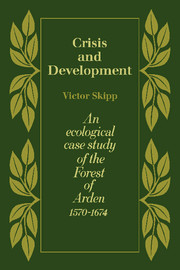Book contents
- Frontmatter
- Contents
- List of figures
- List of tables
- Acknowledgements
- PART ONE THE CONTEXT
- PART TWO THE CASE STUDY
- 4 The demographic crisis of 1613–19
- 5 Negative responses
- 6 The ecological problem
- 7 Positive responses: agrarian change
- 8 Positive responses: new employment openings
- 9 Model of demographic, economic and social developments, 1575–1649
- 10 The new ecological regime, 1625–74
- 11 The social cost
- PART THREE IMPLICATIONS
- Appendix 1 The practice of birth control
- Appendix II Estimates of population size
- Notes
- Index
10 - The new ecological regime, 1625–74
Published online by Cambridge University Press: 05 November 2011
- Frontmatter
- Contents
- List of figures
- List of tables
- Acknowledgements
- PART ONE THE CONTEXT
- PART TWO THE CASE STUDY
- 4 The demographic crisis of 1613–19
- 5 Negative responses
- 6 The ecological problem
- 7 Positive responses: agrarian change
- 8 Positive responses: new employment openings
- 9 Model of demographic, economic and social developments, 1575–1649
- 10 The new ecological regime, 1625–74
- 11 The social cost
- PART THREE IMPLICATIONS
- Appendix 1 The practice of birth control
- Appendix II Estimates of population size
- Notes
- Index
Summary
After the culling of the 1610s, the populations of the five parishes seem again to have been growing vigorously throughout the second generation of the seventeenth century. 2,797 baptisms are recorded between 1620 and 1649, as against only 1,745 burials, giving a natural increase rate of 60%. Among couples marrying 1625–49, mean life expectation at marriage goes up by 1.4 years on the crisis generation; the childbearing span by 1.8 years (Table I and Fig. 3). Similarly, closed family size rises from 2.9 to 3.7 children; and completed family size from 4.1 to 4.4.
Meanwhile, the number of reproducing surnames, which had fallen so sharply between 1610 and 1629, is again increasing (Fig. 4). However, many of the new names – at least during the 1630s – were probably brought in by single males; for, in contrast to the previous generation (see p. 16), the surname increase is matched by a corresponding rise in the number of marriages (Fig. 5). Eight people are known to have erected cottages on the Solihull commons between 163 2 and 1647; but most of them seem to have been of native stock rather than recent immigrants.
There were high mortalities in the years 1635–9. Yet although a scarcity of corn is reported for Warwickshire in 1638 and 1639, there are no signs of dearth locally. Burials rise in the registers, but baptisms remain well above them (Fig. 20). Almost certainly, the main cause of the trouble was epidemic disease. Nationally, the five years 1646–51 brought a run of bad harvests, and the Warwick Quarter Sessions records speak of ‘the present dearth’ in 1647 and ‘this hard and miserable time’ in 1649.
- Type
- Chapter
- Information
- Crisis and DevelopmentAn Ecological Case Study of the Forest of Arden 1570–1674, pp. 75 - 78Publisher: Cambridge University PressPrint publication year: 1978



